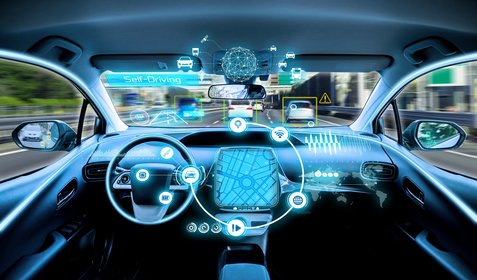
22/05/2018
Autonomous vehicles, more cities engaged in safety tests
Dino Collazzo
According to a recent classification by Bloomberg Philanthropies over one hundred cities around the world are currently engaged in testing self-driving cars and the list keeps growing with North America and Europe leading the way. By 2030 this market segment might be worth around 95 billion dollars.
“Relax and enjoy the journey”. This is how, in a not too distant future, a voice assistant will greet us each time we get in a car. No more hands clutching a steering wheel or pedals to push: this is the dawning of the autonomous driving era. The whole idea of using vehicles controlled by artificial intelligence able to independently “communicate” with surrounding structures and systems is rapidly spreading. And as the race towards the future of mobility picks up momentum, more and more cities around the world are engaged in real street-tests. The initial versions of level 4 vehicles (high automation) - level 5 (totally autonomous driving) will require a much longer period of time - could be ready as early 2020. However, according to several analysts, to see an exponential growth of the market we will likely have to wait until 2025. The main reason being that all existing infrastructures need to be upgraded, including the creation of "smart-roads": roads and road signs equipped with intelligent sensors that can interface and communicate with vehicles and are able to support 5G connection.
Autonomous driving tests around the world
According to a ranking issued by Bloomberg Philanthropies together with the Aspen Institute, the number of cities around the world currently testing self-driving vehicles are over a hundred. The largest number of these are found in North America (45), followed by Europe (31), China (10) and Australia (5). The list, which is constantly updated, includes both the cities in which the pilot programs have already started or are about to start, as well as those where all the regulatory procedures needed to program the tests are being fulfilled. The first case includes 67 cities such as Washington, Miami, Singapore, Berlin, Paris, London, Dubai and Sidney, just to name a few, where a self-driving vehicle is moving within a given area, facing the traffic, tackling intersections and learning to detect signs and traffic lights.
Current developments in Italy
What about Italy? It is now possible to test autonomous vehicles in Italy too, and universities, public and private research entities and manufacturers have received the green light as far as obtaining the necessary permits. Leading the way is Milan followed close behind by Turin and L'Aquila. The first tests are part of a larger project programmed by the Ministry of Infrastructure and Transport and has also been included in the latest Budget Law: the goal is the creation of "smart-roads", or connected roads equipped with systems able to make autonomous driving possible in the safest possible conditions. The initial phase, which according to the ministry's forecasts should be completed by 2025, will see all the infrastructures belonging to the European Ten-T network (Trans European network - Transport) as well as new motorways and state highways being the object of a comprehensive technological upgrade and extraordinary maintenance. Additional services will be implemented by 2030, such as traffic flow deviations in the event of accidents, new measures on average speeds to avoid congestion and bottlenecks, dynamic management of lanes, new access points to motorways as well as parking and refuelling.
5G connectivity will be the main theme of this digital development with the European Union ready to invest as much as 200 million euro on fifth generation networks. One of the projects that is likely to benefit the most from this technological upgrade is autonomous driving, besides additional programs involving health, energy and the media. The 5G road map, drawn up in Brussels, is divided into two stages. The first is to have a few services available in at least one large city in each EU member state by 2020. The second stage, which includes extending the infrastructures to all the Union’s most important urban areas, should be completed by 2025.
Autonomous cars market
The widespread use of Adas systems (Advanced Driver Assistance systems), on newly registered cars, is radically changing the whole concept of driving. It is not unusual, in fact, to come across cars with a level 3 system capability (conditional automation). These are vehicles able to drive on their own by managing acceleration, braking and steering. In this case the driver is a “spectator” ready to regain control at any time, especially when potentially dangerous situations arise or in areas where autonomous driving is not allowed or is considered too dangerous. But change is in the air and level 4 capability is close at hand. In market terms, booming figures, according to AT Kearney, are expected by 2030. That is when, according to analysts, the autonomous driving market could be worth as much as 95 billion dollars. A value destined to rapidly rise up to 282 billion, if we include developments on connected equipment and necessary technological infrastructures. AT Kearney, though, goes even further. In fact, 2030 might turn out to be a pivotal year, a springboard towards the real market boom that will follow. Vehicles equipped with Cruise Av – totally autonomous vehicles without a steering wheel, pedals and any other manual control – are likely to hit our streets in the following five years, pushing up the overall value of the market that will probably rocket to about 560 billion dollars and self driving cars will make up 17% of the entire world car market.
Autonomous driving tests around the world
According to a ranking issued by Bloomberg Philanthropies together with the Aspen Institute, the number of cities around the world currently testing self-driving vehicles are over a hundred. The largest number of these are found in North America (45), followed by Europe (31), China (10) and Australia (5). The list, which is constantly updated, includes both the cities in which the pilot programs have already started or are about to start, as well as those where all the regulatory procedures needed to program the tests are being fulfilled. The first case includes 67 cities such as Washington, Miami, Singapore, Berlin, Paris, London, Dubai and Sidney, just to name a few, where a self-driving vehicle is moving within a given area, facing the traffic, tackling intersections and learning to detect signs and traffic lights.
Current developments in Italy
What about Italy? It is now possible to test autonomous vehicles in Italy too, and universities, public and private research entities and manufacturers have received the green light as far as obtaining the necessary permits. Leading the way is Milan followed close behind by Turin and L'Aquila. The first tests are part of a larger project programmed by the Ministry of Infrastructure and Transport and has also been included in the latest Budget Law: the goal is the creation of "smart-roads", or connected roads equipped with systems able to make autonomous driving possible in the safest possible conditions. The initial phase, which according to the ministry's forecasts should be completed by 2025, will see all the infrastructures belonging to the European Ten-T network (Trans European network - Transport) as well as new motorways and state highways being the object of a comprehensive technological upgrade and extraordinary maintenance. Additional services will be implemented by 2030, such as traffic flow deviations in the event of accidents, new measures on average speeds to avoid congestion and bottlenecks, dynamic management of lanes, new access points to motorways as well as parking and refuelling.
5G connectivity will be the main theme of this digital development with the European Union ready to invest as much as 200 million euro on fifth generation networks. One of the projects that is likely to benefit the most from this technological upgrade is autonomous driving, besides additional programs involving health, energy and the media. The 5G road map, drawn up in Brussels, is divided into two stages. The first is to have a few services available in at least one large city in each EU member state by 2020. The second stage, which includes extending the infrastructures to all the Union’s most important urban areas, should be completed by 2025.
Autonomous cars market
The widespread use of Adas systems (Advanced Driver Assistance systems), on newly registered cars, is radically changing the whole concept of driving. It is not unusual, in fact, to come across cars with a level 3 system capability (conditional automation). These are vehicles able to drive on their own by managing acceleration, braking and steering. In this case the driver is a “spectator” ready to regain control at any time, especially when potentially dangerous situations arise or in areas where autonomous driving is not allowed or is considered too dangerous. But change is in the air and level 4 capability is close at hand. In market terms, booming figures, according to AT Kearney, are expected by 2030. That is when, according to analysts, the autonomous driving market could be worth as much as 95 billion dollars. A value destined to rapidly rise up to 282 billion, if we include developments on connected equipment and necessary technological infrastructures. AT Kearney, though, goes even further. In fact, 2030 might turn out to be a pivotal year, a springboard towards the real market boom that will follow. Vehicles equipped with Cruise Av – totally autonomous vehicles without a steering wheel, pedals and any other manual control – are likely to hit our streets in the following five years, pushing up the overall value of the market that will probably rocket to about 560 billion dollars and self driving cars will make up 17% of the entire world car market.












